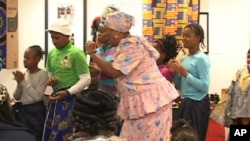It's a week-long celebration called Kwanzaa, an African-American cultural holiday founded in the United States during the black power movement of the 1960s. Today, hundreds of thousands of African-Americans across the U.S. observe Kwanzaa during the week leading up to New Year's Day on January 1.
At the Anacostia Community Museum in Southeast Washington, the adults officiating over this Kwanzaa gathering make certain all the children get up to dance. Kwanzaa was essentially created in 1966 by a black activist named Maulana Karenga. He designed the holiday to help black Americans recognize their African heritage - and in turn to be proud of their African-American culture.
The holiday is rooted in West African traditions like the winter harvest. Wanda Aikens is a community activist. She remembers the first Kwanzaa gatherings that were being organized back in 1966.
"We began to understand that the harvesting that we would experience through Kwanzaa is really the same as people here would celebrate New Year's," said Aikens. "You think about the seeds you have planted, you think about all the activities, all the visions, the missions, all the inspirations that you want to have. Not just in yourself but in your community. And we began to put all those things together for Kwanzaa."
Kwanzaa celebrations center around the lighting of seven candles - each one representing a key principle of life such as unity, self-determination, creativity and faith. Gift giving is also a Kwanzaa tradition. Aikens remembers the simple gifts she exchanged more than 40 years ago.
"When I was young we took oranges, because oranges were so precious," recalled Aikens. "Everybody didn't have oranges. And you would take the old lace and you would put lace around the oranges and stick cloves in them and make these beautiful oranges. And you would give it to someone maybe tied in a napkin."
Sir Jameson celebrated Kwanzaa as a boy in the 1980s. He's here today with his family to pass down the seven principles of Kwanzaa to his children including his toddler son named Seven.
"I did a little bit of Kwanzaa in the 90s, but I strayed away from Kwanzaa and I want to get back into it now that I've got my own family and I want to teach them the seven principles of Kwanzaa," said Jameson.
Hadiya Sholtz, 10, came from Philadelphia to play drums here with her little sister. She says her favorite principle of Kwanzaa is Unity.
SHOLTZ: "We don't usually come together a lot in Philadelphia so when I come down here, it's like everyone is coming together for one holiday."
RABIEE: "It feels like a community?"
SHOLTZ: "Yes."
RABIEE: "Like having a big family?"
SHOLTZ: "Yes."
Ivy Hylton has been hosting Kwanzaa celebrations for nearly two decades. Today, she's calling on the celebrants at the Anacostia Museum to offer their New Years' resolutions, based on the Kwanzaa principle of shared community.
"I'm going to make a determined, conscious decision, to spend my dollars at black businesses," said Hylton.
It is estimated that between 500,000 and as many as three million African-Americans observe the holiday, which culminates in a feast on January 1.






